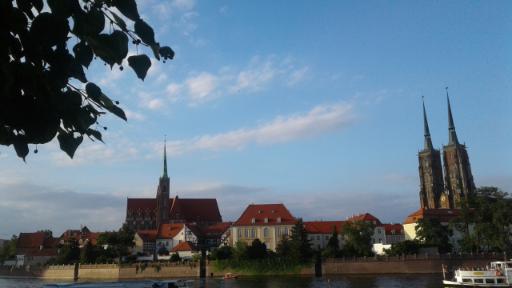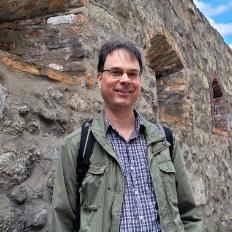S. Rossignol
Position
Associate Professor
Co-editor of Florilegium, journal of the Canadian Society of Medievalists/Société canadienne des médiévistes
Editorial Board, series Later Medieval Europe, Brill (https://brill.com/display/serial/LME?language=en)
Academics
- Banting Postdoctoral Fellowship, Dalhousie University (2011-2013)
- SSHRC Postdoctoral Fellowship, York University (2008-2010)
- Binational Doctorate: Université de Lille 3 and Universität Göttingen (2008)
- M.A. Universität Göttingen (2004)
- B.A. Université de Montréal (2000)
Contact
Department of History
Memorial University of Newfoundland
St. John's, NL A1C 5S7
Email: srossignol@mun.ca
Room: A-4009
Phone: (709) 864-2602
Research Interests
Dr. Sébastien Rossignol is a historian of the European Middle Ages. He believes that the historical, cultural, and religious diversity of the societies of medieval Europe deserves to be better known; his book, co-written with Florin Curta, Medieval East Central and Eastern Europe, contributes to this effort. Rossignol’s main region of interest is Central Europe, as a contact area between Germanic- and Slavic-speaking populations. In the early Middle Ages, the diffusion of Slavic culture in Central Europe profoundly transformed European history. In the high Middle Ages, the migration of German, Flemish, Walloon, and Jewish settlers gave Central Europe its typical cultural and linguistic diversity. In the late Middle Ages, contacts with other parts of the medieval world intensified. These questions are explored in his book Medieval Silesia: An Inclusive History.
Urbanization and the Environment

Sébastien Rossignol’s current research project investigates the impact of urbanization on the natural environment in medieval Silesia of the thirteenth and fourteenth centuries; it has been funded by a SSHRC Insight Development Grant. The project explores changes in the natural environment brought about by urbanization; these included the management of common pasturelands and woodlands, and transformations in the hydrological networks through the construction of watermills and artificial channels. Moreover, the project seeks to understand how these changes and the use of natural resources – woodlands, pastures, water – were conceptualized and how this reflected medieval understandings of inter-connectedness in the natural world. The study is based on charters outlining the use of these resources and municipal law books (most of them still unpublished) describing normative parameters in town and country. The project will culminate in a monograph, currently in preparation.
This interest in environmental history is also reflected in the collective volume Landscapes and Societies in Medieval Europe East of the Elbe (co-edited with Timothy Newfield, Sunhild Kleingärtner, and Donat Wehner).
Charters and the varied practices of reading
Another area of Sébastien Rossignol’s research interests is pragmatic literacy, and particularly the history of reading practices. In a project realized as a SSHRC postdoctoral researcher, Banting fellow, and associate member of the German Historical Institute in Warsaw, Rossignol has inquired into the methods of communication implied by the use of ducal charters in thirteenth- and early fourteenth-century Silesia and Pomerania. The results are published in his book Maiestas principum. The field of charter studies is also explored in the collective volume Urkundenformeln im Kontext (co-edited with Anna Adamska).
Early concepts of urbanization
Sébastien Rossignol’s interest in urbanization goes back to his doctoral research completed at the Universities of Göttingen (Germany) and Lille 3 (France). Rossignol has studied how urbanization was understood in early medieval Central and Northern Europe, in areas without Roman past but in which the earliest sources are in Latin and derived from Roman literary and cultural traditions. The monograph Aux origines de l’identité urbaine en Europe centrale et nordique is based on historical and archaeological sources.
Student Supervision
Dr. Rossignol is available to supervise honours essays and graduate research projects on a variety of subjects related to European history, from the early to the late Middle Ages. In recent years he has supervised projects on gender history, aristocratic culture, chronicles and history-writing, reactions to catastrophes, and various aspects of cultural and social history. He would be interested in supervising research related to environmental history, pragmatic literacy, or intercultural contacts, and is open to discuss other subjects.
Selected Publications
Books
- (with Florin Curta) Medieval East Central and Eastern Europe (Toronto: University of Toronto Press, 2025), 509 pp.
-
Medieval Silesia: An Inclusive History (London: Routledge, 2025), 354 pp.
- Maiestas principum. Herzogsurkunden als Medien der Herrschaftsrepräsentation in Schlesien, Pommern und Pommerellen (1200-1325), Deutsches Historisches Institut Warschau – Quellen und Studien 36 (Wiesbaden: Harrassowitz, 2019), XII + 445 pp.
- Aux origines de l’identité urbaine en Europe centrale et nordique. Traditions culturelles, formes d’habitat et différenciation sociale (VIIIe – XIIe siècles), Haut Moyen Âge 19 (Turnhout: Brepols, 2013), 402 pp.
Edited Volumes
- Sébastien Rossignol and Anna Adamska (ed.), Urkundenformeln im Kontext. Formen der Schriftkultur im Ostmitteleuropa des Mittelalters (13.-14. Jahrhundert), Veröffentlichungen des Instituts für Österreichische Geschichtsforschung 65 (Vienna: Böhlau, 2016), 207 pp.
- Sunhild Kleingärtner, Timothy P. Newfield, Sébastien Rossignol and Donat Wehner (ed.), Landscapes and Societies in Medieval Europe East of the Elbe: Interactions between Environmental Settings and Social Transformations, Papers in Mediaeval Studies 23 (Toronto: Pontifical Institute of Mediaeval Studies, 2013), xiv + 406 pp.
- Alban Gautier and Sébastien Rossignol (ed.), De la mer du Nord à la mer Baltique. Identités, contacts et communications au Moyen Âge. Actes de l’atelier de jeunes chercheurs, Boulogne-sur-Mer, les 15-17 octobre 2009 (Lille: Centre de Gestion de l’Édition Scientifique, 2012), 259 pp.
- Aleksander Paron, Sébastien Rossignol, Bartlomiej Sz. Szmoniewski and Grischa Vercamer (ed.), Potestas et communitas: Interdisziplinäre Beiträge zu Wesen und Darstellung von Herrschaftsverhältnissen im Mittelalter östlich der Elbe. Interdisciplinary Studies of the Constitution and Demonstration of Power Relations in the Middle Ages East of the Elbe (Wroclaw and Warsaw: Polish Academy of Sciences and German Historical Institute in Warsaw, 2010), 373 pp.
- Jean-François Cottier, Martin Gravel and Sébastien Rossignol (ed.), Ad libros! Mélanges d’études médiévales offerts à Denise Angers et Joseph-Claude Poulin (Montréal: Presses de l’Université de Montréal, 2010), 418 pp.
- Anne Klammt and Sébastien Rossignol (ed.), Mittelalterliche Eliten und Kulturtransfer östlich der Elbe. Interdisziplinäre Beiträge zu Archäologie und Geschichte im mittelalterlichen Ostmitteleuropa (Göttingen: Göttinger Universitätsverlag, 2009), 238 pp.
Articles in Peer-Reviewed Journals
- “Visualizing Reading Practices in the Late Middle Ages: Images in a Book of Hours Held at Memorial University,” Florilegium 34 (2017): 90-118 (published in 2021)
- “The Charters of the Princes of Rügen and the Display of Authority,” Zeitschrift für Ostmitteleuropa-Forschung 66,2 (2017): 155-179.
-
“Vivre à l’étranger: otages, rebelles et épouses en Europe centrale et nordique (Xe-XIe s.).” Revue d’histoire nordique 23,2 (2016): 87-104.
- “Doit-on encore parler de colonisation allemande au Moyen Âge? Réflexions sur l’historiographie récente concernant l’Europe du Centre-Est aux XIIe et XIIIe siècles,” Revue historique 680 (2016): 905-940.
- “Civitas, heremus et fondation de monastères en Saxe et chez les Slaves occidentaux au haut Moyen Âge (VIIIe – XIe siècles),” Revue Mabillon n.s. 26 (2015): 5-28.
- “Bilingualism in Medieval Europe: Germans and Slavs in Helmold of Bosau’s Chronicle,” Central European History 47, 3 (2014): 523-543.
- “La localisation des premiers sièges épiscopaux en Europe centrale et nordique. Tradition et adaptation (VIIIe – XIe siècles),” Revue d’histoire ecclésiastique 109, 1 (2014): 64-90.
- “The Authority and Charter Usage of Female Rulers in Medieval Silesia, c. 1200-c. 1330,” Journal of Medieval History 40, 1 (2014): 63-84.
- “Les récits de fondation des urbes et civitates en Europe centrale et centre-orientale (IXe – XIIe siècle),” Cahiers de civilisation médiévale 56, 4, fasc. 224 (2013): 381-405.
- “Civitas in Early Medieval East Central Europe – Stronghold or District?,” Medieval History Journal 14, 1 (2011): 71-99.
- “The Central European Early Town as an Issue of Interdisciplinary Studies,” Przeglad Archeologiczny 57 (2009): 133-141.
Chapters in Edited Collections
- “Noblewomen, Courtly Culture, and the Principality of Rugia in the High Middle Ages.” In Viele Welten des Ostseeraumes: Politischer, wirtschaftlicher und kultureller Austausch vom Hochmittelalter bis zum Beginn der Neuzeit, edited by Paul Srodecki and Ludwig Steindorff, 65-78. Tagungen zur Ostmitteleuropaforschung 43. Marburg: Herder Institut, 2024.
- "Edificatio Civitatis’: Various Perspectives on the Building of Urban Fortifications in Medieval Poland.” In Měesto a jeho hradby / The Town and Its Walls, ed. Olga Fejtová, Martina Mařiková and Jiří Pešek, 361-396. Documenta Pragensia 38. Prague: Archiv hlavního města Prahy, 2019.
-
“The Entry of Early Medieval Slavs into World History: the Chronicle of Moissac.” In The Medieval Networks in East Central Europe: Commerce, Contacts, Communication, ed. Balázs Nagy, Felicitas Schmieder, and András Vadas, 43-57. London and New York: Routledge, 2019.
-
“Les Daleminciens face aux Francs. Conflits, tribut et structures sociales.” In Pillages, tributs, captifs. Prédation et sociétés de l’Antiquité tardive au haut Moyen Âge, ed. Rodolphe Keller and Laury Sarti, 139-160. Histoire ancienne et médiévale 153. Paris: Publications de la Sorbonne, 2018.
- “Femmes et pouvoir en Silésie polonaise. Veuvage, régence et succession (vers 1200-vers 1330),” in Laurent Jégou, Sylvie Joye, Thomas Lienhard and Jens Schneider (ed.), Splendor Reginae. Passions, genre et famille. Mélanges en l’honneur de Régine Le Jan, Haut Moyen Age 22 (Turnhout: Brepols, 2015) 197-203.
- “Die Linonen zwischen Tat und Wort. Die Schriftquellen über die Entwicklung an der unteren Mittelelbe unter Berücksichtigung der interdisziplinären Forschungsergebnisse,” in Karl-Heinz Willroth, Hans-Jürgen Beug, Friedrich Lüth, Franz Schopper, Sebastian Messal and Jens Schneeweiß (ed.), Slawen an der unteren Mittelelbe. Untersuchungen zur ländlichen Besiedlung, zum Burgenbau, zu Besiedlungsstrukturen und zum Landschaftswandel. Beiträge zum Kolloquium vom 7. bis 9. April 2010 in Frankfurt a. M., Frühmittelalterliche Archäologie zwischen Ostsee und Mittelmeer 4 (Wiesbaden: Reichert, 2013), 135-150.
- “Modes de communication dans les emporia de la mer Baltique,” in Alban Gautier and Sébastien Rossignol (ed.), De la mer du Nord à la mer Baltique. Identités, contacts et communications au Moyen Âge. Actes de l’atelier de jeunes chercheurs, Boulogne-sur-Mer, les 15-17 octobre 2009 (Lille: Centre de Gestion de l’Édition Scientifique, 2012), 105-118.
- “Wichmann entre Saxons et Slaves: contacts, échanges et problèmes de communication,” in Alban Gautier and Céline Martin (ed.), Échanges, communications et réseaux dans le haut Moyen Âge. Études et textes offerts à Stéphane Lebecq, Haut Moyen Âge 14 (Turnhout: Brepols, 2012), 181-196.
- “Überlegungen zur Datierung des Traktates des sog. Bayerischen Geographen anhand paläographischer und kodikologischer Beobachtungen,” in Felix Biermann, Thomas Kersting and Anne Klammt (ed.), Der Wandel um 1000. Beiträge der Sektion zur slawischen Frühgeschichte der 18. Tagung des Mittel- und Ostdeutschen Verbandes für Altertumsforschung in Greifswald, 23. bis 27. März 2009, Beiträge zur Ur- und Frühgeschichte Mitteleuropas 60 (Langenweißbach: Beier & Beran, 2011), 305-316.
- “Les ports de la Baltique (VIIIe – IXe siècles),” in Stéphane Lebecq, Bruno Béthouart and Laurent Verslype (ed.), Quentovic. Environnement, archéologie, histoire. Actes du colloque international de Montreuil-sur-Mer, Etaples et Le Touquet et de la journée d’études sur les origines de Montreuil-sur-Mer (11-13 mai 2006 et 1er décembre 2006), UL3. Travaux et recherches (Lille: Centre de Gestion de l’Édition Scientifique, 2010), 409-427.
- “À propos du manuscrit du ‘Géographe de Bavière,’” in Jean-François Cottier, Martin Gravel and Sébastien Rossignol (ed.), Ad libros! Mélanges d’études médiévales offerts à Denise Angers et Joseph-Claude Poulin (Montréal: Presses de l’Université de Montréal, 2010), 49-68.
- “Die Burgen der Slawen in den lateinischen Quellen des 9. bis 11. Jahrhunderts,” in Felix Biermann, Thomas Kersting and Anne Klammt (ed.), Siedlungsstrukturen und Burgen im westslawischen Raum. Beiträge der Sektion zur slawischen Frühgeschichte der 17. Jahrestagung des Mittel- und Ostdeutschen Verbandes für Altertumsforschung in Halle an der Saale, 19. bis 21. März 2007, Beiträge zur Ur- und Frühgeschichte Mitteleuropas 52 (Langenweißbach: Beier & Beran, 2009), 31-38.
